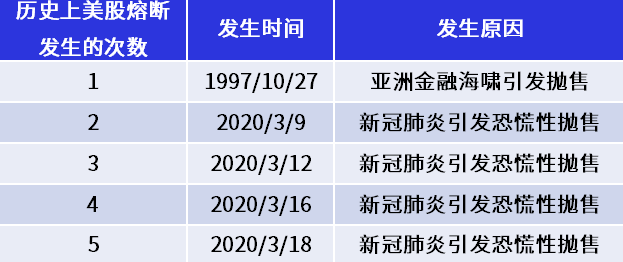What is the fuse mechanism?What is the fuse history of U.S. stocks??
A circuit breaker is a mechanism in which the U.S. stock market is trading, and the market price falls sharply until it hits the circuit breaker, causing the stock market to suspend trading.。

What is the fusing mechanism??
A circuit breaker is a mechanism in which the U.S. stock market is trading, and the market price falls sharply until it hits the circuit breaker, causing the stock market to suspend trading.。It is like a blown fuse. When the market may be overloaded, it is broken in advance to protect the market。
It is understood that the U.S. stock market is limited to three times a day, and global stock markets, not only the United States is using the fuse mechanism, the United Kingdom, South Korea, Japan, the Philippines, Indonesia, China, Thailand and other countries also use the fuse mechanism to protect the stock market.
How the U.S. stock circuit breaker mechanism operates?
The U.S. stock meltdown limit is three times a day, of which, as long as it is at 9 Eastern Time..30 a.m.- 4.30 p.m.Between the occurrence of the index fell 20%, the day will be completely stop trading。

* Note: If the first or second fuse occurs after 15: 25 EST, there will be no fuse because the day is close to closing。
In addition, the rules of the U.S. stock meltdown mechanism have been adjusted several times in the course of development, and before 2013, the index looked at was the Dow Jones Industrial Average (DJ30), while after 2013 it was replaced by the S & P 500 (S & P500), which is also the index looked at by the current meltdown mechanism.。
Causes of Fuse Mechanism
The reason for the meltdown mechanism is simple - to avoid investors using emotions to influence stock market performance。
When the stock market fluctuates significantly, the psychology of investors is severely disturbed, so the market introduces a meltdown mechanism to avoid emotional manipulation of the stock price。
The meltdown mechanism can force investors to suspend trading for a period of time, allowing investors to calm down and think about whether the current operation is appropriate, and wait until the suspension period is over before proceeding.。
Fuses have occurred only five times in history, all during the financial tsunami。Because the stock market crash is often the time when investors are most panicked, there will be a large number of sell-offs, many bystanders also infected with the sell-off sentiment, thus forming a vicious circle.。
Global views on the U.S. stock circuit breaker mechanism
At present, the global market on the U.S. stock meltdown mechanism is polarized, one side believes that the U.S. stock meltdown can indeed achieve the effect of allowing investors to calm down and make correct judgments; the other side believes that the liquidity constraints caused by the U.S. stock meltdown will make investors more panic, but make more irrational behavior.。
Because investors will be more anxious while losing liquidity, sellers will continue to sell because of panic; buyers will continue to wait because they want to start at a lower price, resulting in a larger decline after the end of the trading suspension.。Opponents therefore argue that without a meltdown mechanism for U.S. stocks, it would instead bring the stock market into a more reasonable equilibrium.。
The Meltdown History of the US Stock Market
The reason why U.S. stocks initially set up a meltdown mechanism was that during the Black Monday financial turmoil of 1987, the S & P 500 recorded its biggest one-day decline in history, when it plunged 18 percent, while the Dow Jones Industrial Average also fell 22 percent..61%, crippling the exchange system at the time。
In February of the following year, the U.S. Securities and Exchange Commission (SEC) established a U.S. stock circuit breaker mechanism to prevent similar incidents from happening again.。
Since the establishment of the mechanism of about 10 years, U.S. stocks have not triggered a meltdown, until October 27, 1997, the birth of the Asian financial turmoil, the same day the Dow Jones industrial index immediately after the opening of the market plunged 7.18%, triggered the first fuse in history。
And in the next 20 years did not happen again, until March 9, 2020 due to the impact of the new coronary pneumonia, resulting in a large number of investors panic selling their stocks, so that the S & P 500 index fell more than 7%, triggering a second U.S. stock meltdown.。
Not only that, the S & P 500 index in the next 10 days there are three more meltdowns, respectively, 3 / 12, 3 / 16, 3 / 18 each fell more than 7%, in March 2020 triggered a total of four times.。

Impact of US Stock Fuse
Regarding stocks
Since the U.S. stock meltdown is triggered by the movement of the S & P 500 index, the S & P 500 is the 500 common stocks in the U.S. market, accounting for 80% of the total U.S. market capitalization.。
In other words, it would take an average of 7% drop in these 500 stocks to cause the S & P 500 to follow suit.。If a meltdown occurs, it means that most U.S. stocks have fallen more than 7 percent.。
To the market
When a meltdown occurs, it often means that the overall market is going in a bad direction, the operation of the market, companies will be hindered or have been hindered, which in turn affects people's livelihoods, resulting in reduced incomes, rising unemployment, stagnant production, falling demand and other chaotic phenomena, at this time, usually the stock market is entering a bear market or is already in a bear market。
For investors
And the meltdown adds a bit of panic to investors, in addition to devaluing the stock on hand, but it can also be a rare opportunity to examine whether their asset allocation is in a healthy state。
What should be paid attention to when encountering a U.S. stock circuit breaker?
U.S. stock meltdowns do not happen every day, and if investors encounter a rare meltdown, they can take this opportunity to check the health of their stocks and asset allocation, and to calm down and analyze the reasons in a full-blown panic atmosphere to find opportunities.。
At this point, it's important for investors to understand the company's fundamentals。If investors know that the decline in stocks is not a problem for the company, that they may be implicated in the overall stock market crash, and that this stock market crisis will not harm the company's fundamentals, then they should not be affected by sentiment and sell their stocks, but should wait for the opportunity to buy them at a share price below a reasonable price.。
You know how rare U.S. stock meltdowns have been in the more than 30 years since the meltdown mechanism was established in 1987, with only five meltdowns, four of which occurred during the same period.。
·Original
Disclaimer: The views in this article are from the original Creator and do not represent the views or position of Hawk Insight. The content of the article is for reference, communication and learning only, and does not constitute investment advice. If it involves copyright issues, please contact us for deletion.